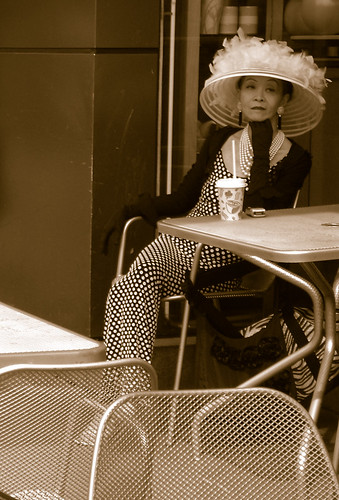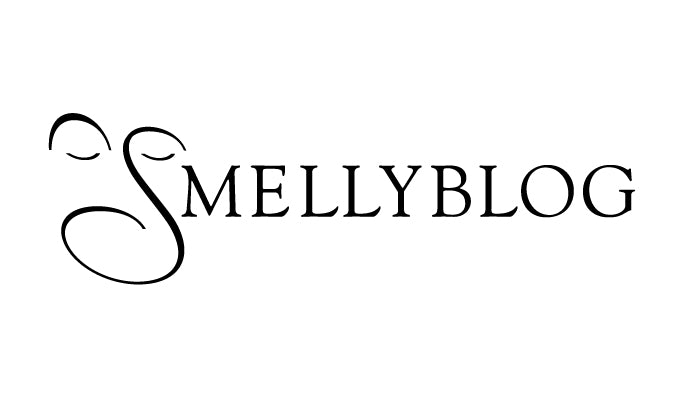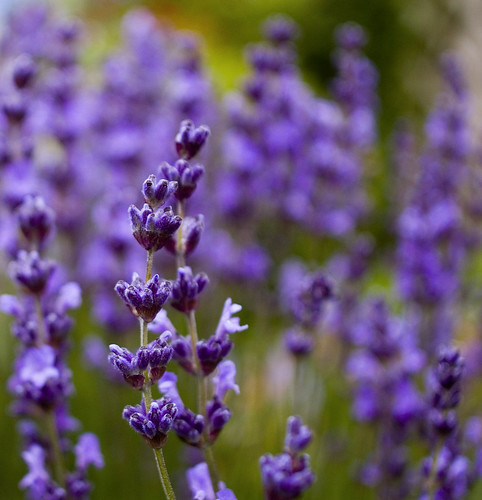Immortelle l'Amour and Vetiver Racinettes on SavvyThinker.com
Concrete
In contrary to the low expectations I had from Narciso Rodriguez for Her, which lead (after several twists and turns of the plot) to a surprising delight from what seemed to be just another non-descript trendy floral – the launch of Narciso Rodriguez for Him had at least a seed of expectations on my part. One would expect that it would do to Fougere what For Her did to Chypre – meaning: disregard it completely and instead, invent a new modern floral category (abstract musky floral). In the case of fougere (also a composition reliant on oakmoss, this time contrasted with lavender), one would anticipate we’ll see the birth of a musky lavender, something not all that far from Sarah Jessica Parker’s Lovely – but perhaps a bit masculinized.
However, I am sorry to report that none of that happened. I stepped into Holt Renfrew the other night accompanied by my brother Noam - a budding perfumista with a collection that could not embarrass a gentlemen twice his age (of course I will only take partial responsibility over his interest in fragrance). His immediate reaction was disgust (and we are talking about a young man who consents to the title fragrance whore –seriously, there is hardly anything he doesn’t like!).
From the moment For Him was sprayed on the paper stripe, I could not help but think of concrete. The opening notes are bizarre and somewhat disturbing. There is a hint of honey, reminiscent of the honey flower note in For Her. But one can tell right away that there is nothing groundbreaking about this fougere at all. Like most modern fougeres, the lavender is very refined, the oakmoss very subdued. Synthetic notes take over, usually with a metallic coolness that reflects more of the methods the scent was created (by machines) than the human inspiration (if there was any involved).
 To me, the scent just confirmed a strong connection to the bizarre choice of colour for the bottle – a concrete gray of the most depressing hue I’ve seen in a long time. If this was fabric, perhaps I would be able to find some comfort in it. But being made of a thick cold shiny glass makes one feel just that – cold and “correctic”. Nothing more. It seems Narciso Rodriguez has simultaneously run out of ideas for his bottle’s colors and the scent of their contents. They say a picture is worth a thousand words. And I think the posted ad for this fragrance says it all: it’s the cliché of a fragrance ad for men – chest exposed medium shot of a young man - nothing surprising, except, perhaps, the extremely dark thick hair and the supposedly-mysterious lack of eye contact.
To me, the scent just confirmed a strong connection to the bizarre choice of colour for the bottle – a concrete gray of the most depressing hue I’ve seen in a long time. If this was fabric, perhaps I would be able to find some comfort in it. But being made of a thick cold shiny glass makes one feel just that – cold and “correctic”. Nothing more. It seems Narciso Rodriguez has simultaneously run out of ideas for his bottle’s colors and the scent of their contents. They say a picture is worth a thousand words. And I think the posted ad for this fragrance says it all: it’s the cliché of a fragrance ad for men – chest exposed medium shot of a young man - nothing surprising, except, perhaps, the extremely dark thick hair and the supposedly-mysterious lack of eye contact.
If it was indeed inspired by the “great fougeres of the 80’s" than we must look back and try to remember these. Cool Water by Davidoff comes to mind, with its antiseptic Jacuzzi cleaner sillage and metal bladed breath. Anything inspires by that (or the 80’s, for that matter) is likely to make me shudder… Considering that real, sophisticated, original fougeres are originated in the 80’s of the previous century, it does make one wonder.
For Him opens with a disturbing bouquet of both dry cement and wet concrete, unrecognizable  spices and a honey note. The intrigue dissipates quickly when the scent becomes a familiar, I’ve-smelled-this-before modern fougere accord – a hint of fake herabceous water, some non-descript fruity sweetness that is fortunately not quite nausearing, but just almost (it reminds me quite a bi t of the sweetness of Jean-Payl Gaultier for men, only with the sillage toned down 10 fold); a glimpse of violet leaf coolness and a certain smokiness that my brother describes as ‘ashtray smell” but at the same time he also detects some good smelling fresh herb notes. The dry down settles within about an hour – a close to the skin, rather soft, undecisive mélange of amber and musk (it is also said to contain patchouli, but I can’t say I am recognizing any). Nothing offensive in the drydown, and the sillage is soft and non overpowering – the contrary of what I’ve expected after the magical sillage and staying power of For Her (it has a tendency to stay everywhere after it was applied, and even withstand a laundry – yet it does it with a nice touch of mischevious elegance – almost like Josephine’s deliberate musk contamination before leaving Napoleon’s palaces). The only thing that truly stands out (if you take a very close look) is an animalic ambergris note, somewhat fecal, but with such low-key vibrations it can never offend and unelss you’ve smelled it before it would be very hard to put your finger on it. It reminds me of l’Antimateirer; unfortunately, in this instance one needs to wait a long time for it to emerge. And this might just be its chance for success.
spices and a honey note. The intrigue dissipates quickly when the scent becomes a familiar, I’ve-smelled-this-before modern fougere accord – a hint of fake herabceous water, some non-descript fruity sweetness that is fortunately not quite nausearing, but just almost (it reminds me quite a bi t of the sweetness of Jean-Payl Gaultier for men, only with the sillage toned down 10 fold); a glimpse of violet leaf coolness and a certain smokiness that my brother describes as ‘ashtray smell” but at the same time he also detects some good smelling fresh herb notes. The dry down settles within about an hour – a close to the skin, rather soft, undecisive mélange of amber and musk (it is also said to contain patchouli, but I can’t say I am recognizing any). Nothing offensive in the drydown, and the sillage is soft and non overpowering – the contrary of what I’ve expected after the magical sillage and staying power of For Her (it has a tendency to stay everywhere after it was applied, and even withstand a laundry – yet it does it with a nice touch of mischevious elegance – almost like Josephine’s deliberate musk contamination before leaving Napoleon’s palaces). The only thing that truly stands out (if you take a very close look) is an animalic ambergris note, somewhat fecal, but with such low-key vibrations it can never offend and unelss you’ve smelled it before it would be very hard to put your finger on it. It reminds me of l’Antimateirer; unfortunately, in this instance one needs to wait a long time for it to emerge. And this might just be its chance for success.
Goats and Lavender
While Pan perfume takes its inspiration from the fascinating tale of Pan as it’s told over the magical pages of Jitterbug Perfume – the fragrance itself is not as inspirational as it could have been. If the perfume in Jitterbug was designed to mask the carnal, throaty aroma of the goat god with beet blossoms, citron and patchouli - in Pan it is an extract from that exact animal itself that lends the perfume a glimpse of a godly nature.
Pan can be credited to be the first perfume to employ goat-hair tincture (a cruelty-free animal note). Aside from that, it is a straight-forward ambery-fougere, employing the berry-like Seville lavender absolute as an anchoring note, and the required oakmoss absolute as the base to create a fougere reaction. Other notes include cedar, white lotus, beeswax, patchouli and labdanum, and create a smooth ambery-fougere with hints of suede-like leatheriness, mostly resulting from the presence of the above mentioned Seville lavender and labdanum.
Pan is a rather simple, yet very pleasing natural fougere. Aside from the animalic herding-goat note, there are no surprises or turning points within its evolution. This is precisely why it provides a redeeming point from the tropical clutter of Fairchild or the muddy vanilla-citrus of Riverside (now discontinued) from the same perfume house. In the end, it must be its goaty charm that appeals to me the most – growing in the countryside amongst herding goats gave me no option but to take into liking anything remotely goatly. And now only one question remains: will goat hair tincture become a staple on the natural perfumer's organ? And even if it doesn't - what else can be achieved using this unusual raw material?
To read other reviews and opinions of Pan, visit:
Anya's Garden
Perfume Shrine
Yerbamate
My struggle with green fragrance per-se has never been a secret. Yes somehow, Fougères never posed any struggle for me. Their intense complexity, the headiness of herbs tamed by mossy undergrowth and, as I said, the “bittersweetness” of green” makes it easy for me. Fougères make me feel confident. Perhaps it is their intense masculinity (by association or design? This is hard to tell, as we are pre-programmed to believe in the masculinity of Fougère simply by the bold packaging and the fact that most of our fathers – particularly the ones who shaved and bothered with aftershave – smelled like this kind or another of Fougère – and Brut comes to mind effortlessly as an example).
I’ve stumbled upon two unusual, modern, bittersweet greens: Yohji and Yerbamate. The first being more of a green oriental rather than Fougère – combining an unusual dosage of galbanum (to the point of choking! And what’s more – its combined with a weird aquatic top note as well that is almost off-putting at first, until one gets used to the inseparable oddness of the entire composition, which is precisely what makes it so wonderful on those days when you’re in the mood for it). The combination of galbanum, a spritz of ozone, caramel, raspberry and an overdose of coumarin and vanilla at the base, which turns powdery after hours of wearing is unusual, odd, strange and at the same time appealing.
The other scent, Yerbamate, is a lot easier to stomach at first. Starting terribly green, nearly to the point of an Absinthe poisoning, I was always surprised I’ve enjoyed it so. I detect a fair amount of lavender as well as Artemisia, and again a very odd green – this time not only from galbanum, but also from the unusual note of tomato leaf. But what begins astringent and bitter like a very dry Martini suddenly changes direction and turns into an uber-sweet concoction. There is non of the berries or caramel here, yet like most of Villoresi’s scents (I find), it ends with a very sweet amber. This time, the amber is cleverly concealed amongst heaps of dried hay and powdery coumarin. If you think of a hay ride (or a more grown up type of hay ride), this would be a surprisingly soft one. And this is to the point of extreme indulgence in powdery ambery feathery fluff bordering on the dessert kind. The sip of bitter yerbamate was rewarded by sweetness that would have made you forget you might heard that name earlier…
To give you a completely different view of this prestigiously sought-after perfume, I will have to share with you a little story which my perfume friend Alden shared with me – simply because it put a big grin on my face in a much needed moment: “I read so many wonderful reviews about Yerbamate. I adore all things greens. So I was on a quest for perfection. It was first on my list of must-smells last Thanksgiving in NYC. I read the company's description over and over until I was virtually spellbound. So, I go up the sixth floor of Yah-whatever the Japanese department store on 5th Avenue and wander over. I spritz. Smells exactly like Canoe. I giggle and leave with a silly smile on my face. Anyway, I just wanted to share.” Thanks for sharing, Alden!
I haven’t had the opportunity to smell Canoe in recent years (the one time it turned out in the drugstore as a candidate for grandpa’s Christmas gift there were no testers, and that was about 6 years ago), but I can say oe thing about Yerbamate: it’s a fougere. And the emphasis here is on the concept of fougere, of juxtaposing fresh green with dry green (literally – as in dried hay); of bitter and sweet; of sharp and soft. Yerbamate may be the name, but I wouldn’t say it particularly stands out. It just adds to the extremeness of bitters at first, and than disappears like a Gaucho into the night.

Top Notes: Citrus, Tarragon, Tea, Maté, Rosewood, Ylang Ylang, Galbanum
Middle Note: New Mown Hay, Tomato Leaves, Lavender, Tea, Maté
Base Notes: Galbanum, Labdanum, Benzoin, Maté, Vetiver, Sweet and Powdery Notes
* Yerbamate bottle image from Barfumeria.com
Bois des Îles

She sits at the café. She just arrived from another era. She is not quite sure where she is, but she can recognize an urban heaven when she sees it. In her lacy gloved hand, she slowly lifts a lided paper coffee cup, and indulgently sips the warm elixir inside. Peacefully watching passers by as if completely unaware that she is the one who’s being watched. With her striking European chic outfits, complete with brimmed hat, carefully made-up brows and powdered face and dark lipstick her presence is enigmatic and foreign not only to her Asian features but also to the laid-back Pacific Northwest’ small-town mentality.
And just as her entrance into our lives was mysterious, so was her sudden disappearance one summer day. All I could gather was that I was not the only one sneaking curious gazes at her lacy brimmed hat and gloves, wondering if they might be covering some dreadful secret rather than evidence that she was indeed a time traveler… All I know is that she was not a hallucination of my dreams. Besides my success at capturing her image with my digital camera, I also found out that she disappeared on August 6th, 2007, and left behind a trail of mystery, including puzzled baristas who remembered her favourite drink was French Vanilla coffee – nothing fancy, just straight from the tap.
Perfume transcends the intangible mystery of time. And just like the presence of the mysterious time traveler, it enters our life suddenly and disappears without warning. Perhaps this was why when I saw her I smelled a phantom breath of Bois des Îles: a perfume that silently entered my consciousness and whose beauty I was unable to appreciate years ago because of its antiquated aldehydic moments and the vagueness of its intentions.
Years later, my reflections on Bois des Îles have been refined and clarity is starting to bring me more pleasure from this jus treasured within the crystal cut flacon. Without taking away from its mystery I can enjoy it and indulge in discerning the notes as they lazily dance on my skin. First come bergamot and aldehydes, which take some time to fade away. They are oily and bring to mind the somewhat uric aspect of sandalwood, and the somewhat sharp (at first) nuances of heady ylang ylang. As the aldehydic cloud settles, Bois des Îles becomes deliciously warm, with the spiciness of dry ginger and nutmeg. Sandalwood embraces the perfume throughout its evolution. Although there are floral notes in the heart (namely jasmine and rose), ylang ylang is the only one that truly stands out. The others are blended to complement the sandalwood and ylang ylang (smoothing and rounding its sharpness) and bridge from top to base and the crisp-woody notes of vetiver. And in the final movement choreographed on my skin, the sweetness of vanilla absolute, tonka and benzoin feels like a silky caress of soft lips and warm sand. Top notes: Aldehydes, Bergamot, Ylang Ylang
Top notes: Aldehydes, Bergamot, Ylang Ylang
Heart notes: Jasmine, Rose, Nutmeg, Ginger
Base notes: Sandalwood, Vetiver, Tonka, Vanilla, Benzoin
P.s. This review is for the pure parfum, which unfortunately is no longer available in the Chanel boutiques as the beautiful and elegant crystal flacon of this jus had to make room for the ridiculously gigantic Eaux of the Les Exclusifs. Let’s hope the executives at Chanel smarten up and bring it back. After all, the extraits are the best way to wear the Chanel classics.
P.s.s. Coffret of vintag Chanel flacons was taken from this auction.




